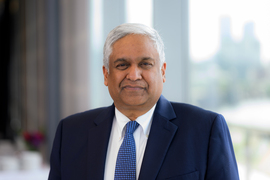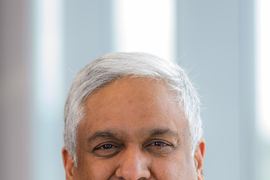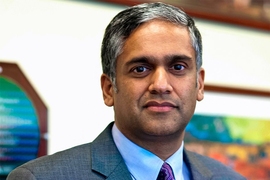Audio
Anantha Chandrakasan, a professor of electrical engineering and computer science who has held multiple leadership roles at MIT, has been named the Institute’s new provost, effective July 1.
Chandrakasan has served as the dean of the School of Engineering since 2017 and as MIT’s inaugural chief innovation and strategy officer since 2024. Prior to becoming dean, he headed the Department of Electrical Engineering and Computer Science (EECS), MIT’s largest academic department, for six years.
“Anantha brings to this post an exceptional record of shaping and leading important innovations for the Institute,” wrote MIT President Sally Kornbluth, in an email announcing the decision to the MIT community today. “I am particularly grateful that we will be able to draw on Anantha’s depth and breadth of experience; his nimbleness, entrepreneurial spirit and boundless energy; his remarkable record in raising funds from outside sources for important ideas; and his profound commitment to MIT’s mission.”
The provost is MIT’s senior academic and budget officer, with overall responsibility for the Institute’s educational programs, as well as for the recruitment, promotion, and tenuring of faculty. With the president and other members of the Institute’s senior leadership team, the provost establishes academic priorities, manages financial planning and research support, and oversees MIT’s international engagements.
“I feel deeply honored to take on the role of provost,” says Chandrakasan, who is also the Vannevar Bush Professor of Electrical Engineering and Computer Science. “Looking ahead, I see myself as a key facilitator, enabling faculty, students, postdocs, and staff to continue making extraordinary contributions to the nation and the world.”
Investing in excellence
Chandrakasan succeeds Cynthia Barnhart, who announced her decision to step down from the role in February. As dean of engineering, Chandrakasan worked with Barnhart closely during her tenure as provost and, before that, chancellor.
“Cindy has been a tremendous mentor,” he says. “She is always very thoughtful and makes sure she hears all the viewpoints, which is something I will strive to do as well. I so admire how deftly she approaches complex problems and supports a variety of perspectives and approaches.”
As MIT’s chief academic officer, Chandrakasan will focus on three overarching priorities: understanding institutional needs and strategic financial planning, attracting and retaining top talent, and supporting cross-cutting research, education, and entrepreneurship programming. On all of these fronts, he plans to seek frequent input from across the Institute.
“Recognizing that each school and other academic units operate within a unique context, I plan to engage deeply with their leaders to understand their challenges and aspirations. This will help me refine and set the priorities for the Office of the Provost,” Chandrakasan says.
He also plans to establish a provost faculty advisory group to hear on an ongoing basis from faculty across the five schools and the college, as well as student/postdoc advisory groups and an external provost advisory council.
“My goal is to continue to facilitate excellence at MIT at all levels,” Chandrakasan says.
He adds: “There is a tremendous opportunity for MIT to be at the center of the innovations in areas where the United States wants to lead. It’s about AI. It’s about semiconductors. It’s about quantum, the biosecurity and biomanufacturing space — but not only that. We need students who can do more than just code or design or build. We really need students who understand the human perspective and human insights. This is why collaborations between STEM fields and the humanities, arts and social sciences, such as through the new MIT Human Insights Collaborative, are so important.”
In her email to the MIT community, Kornbluth also noted that Institute Professor Paula Hammond, currently vice provost for faculty, will take on an expanded portfolio with the new title of executive vice provost, and Deputy Dean of Engineering Maria Yang will serve as interim dean until the new dean is in place.
Advancing the president’s vision
In February 2024, Chandrakasan was appointed at MIT’s first chief innovation and strategy officer, to help develop and implement plans to advance research, education, and innovation in areas that President Kornbluth identified as her top priorities.
Working closely with the president, Chandrakasan oversaw MIT’s launch of several Institute-wide initiatives, including the MIT Human Insight Collaborative (MITHIC), the MIT Health and Life Sciences Collaborative (MIT HEALS), the MIT Generative AI Impact Consortium (MGAIC, or “magic”), the MIT Initiative for New Manufacturing (INM), and multiple energy- and climate-related initiatives including the MIT-GE Vernova Energy and Climate Alliance.
These initiatives bring together MIT faculty, staff, and students from across the Institute, as well as industry partners, supporting bold, ground-breaking research and education to address pressing problems. In launching them, Chandrakasan was responsible for the “full stack” of tasks, from developing the vision to finding funding to implementing the programming — a significant undertaking on top of his other responsibilities.
“People consider me intense, which might be true,” he says, with a chuckle. “The reality is that I’m deeply passionate about the academic mission of MIT to create breakthrough technologies, educate the next generation of leaders, and serve the country and the world.”
New models for collaboration
During his time as dean of engineering, Chandrakasan played a key role in advancing a variety of historic Institute-wide initiatives, including the founding of the MIT Schwarzman College of computing and the development of the MIT Fast Forward plan for addressing climate change. He also served as the inaugural chair of the Abdul Latif Jameel Clinic for Machine Learning in Health and as the co-chair of the academic workstream for MIT’s Task Force 2021. Earlier, he led an Institute-wide working group to guide the development of policies and procedures related to MIT’s 2016 launch of The Engine, an incubator and accelerator for tough tech, and also served on its inaugural board.
He implemented a variety of interdisciplinary programs within the School of Engineering, creating new models for how academia and industry can work together to accelerate the pace of research. This work led to multiple new initiatives, such as the MIT Climate and Sustainability Consortium, the MIT-IBM Watson AI Lab, the MIT-Takeda Program, the MIT and Accenture Convergence Initiative, the MIT Mobility Initiative, the MIT Quest for Intelligence, the MIT AI Hardware Program, the MIT-Northpond Program, the MIT Faculty Founder Initiative, and the MIT-Novo Nordisk Artificial Intelligence Postdoctoral Fellows Program.
Chandrakasan also welcomed and supported 110 new faculty members to the School of Engineering, including in the Department of Electrical Engineering and Computer Science, which jointly reports between the School of Engineering and the MIT Schwarzman College of Computing. He also oversaw 274 faculty and senior researcher promotion cases in Engineering Council.
One of his priorities as dean was to bolster the School of Engineering’s sense of community, launching several programs to give students and staff a more active role in shaping the initiatives and operations of the school, including the Staff Advice and Implementation Committee (SAIC), the undergraduate Student Advisory Group, the Graduate Student Advisory Group (GradSage), and the MIT School of Engineering Postdoctoral Fellowship Program for Engineering Excellence. Working closely with GradSage, Chandrakasan also played a key role in establishing the Daniel J. Riccio Graduate Engineering Leadership Program.
A champion for EECS research and education
Chandrakasan earned his BS, MS, and PhD in electrical engineering and computer sciences from the University of California at Berkeley. After joining the MIT faculty, he was the director of the Microsystems Technology Laboratories from 2006 until 2011, when he became the EECS department head.
An active researcher throughout his time at MIT, Chandrakasan has led the MIT Energy-Efficient Circuits and Systems Group even while taking on new administrative roles. The group works on the design and implementation of integrated systems, from ultra-low-power wireless sensors and multimedia devices to biomedical systems. Chandrakasan has more than 120,000 citations and has advised or co-advised and graduated 78 PhD students. He says this experience will help him succeed as provost.
“To understand the pain points of our researcher scholars, you have to be in the trenches,” he says.
While at the helm of EECS, Chandrakasan also launched a number of initiatives on behalf of the department’s students. For example, the Advanced Undergraduate Research Opportunities Program, more commonly known as “SuperUROP,” is a year-long independent research program that launched in EECS in 2012 and expanded to the whole School of Engineering in 2015.
Chandrakasan also initiated the Rising Stars program in EECS, an annual event that convenes graduate and postdoc women for the purpose of sharing advice about the early stages of an academic career. Another program for EECS postdocs, Postdoc6, aimed to foster a sense of community for postdocs and help them develop skills that will serve their careers.
As higher education faces new challenges, Chandrakasan says he is looking forward to helping MIT position itself for the future. “I'm not afraid to try bold things,” he says.










